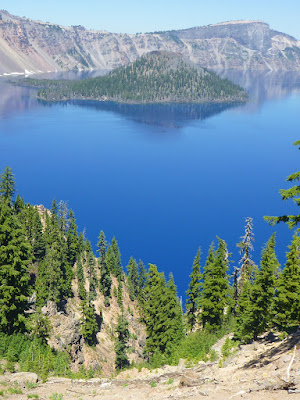Crater Lake's
Merriam Cone is an underwater cinder cone—hidden from view in contrast to
Wizard Island (another cinder cone), which can be seen from almost any place on the rim, including the
Sinnott Memorial Overlook at
Rim Village. While volcanic Wizard Island is named for its
resemblance with a sorcerer's hat, the underwater volcano is named in honor of
John Campbell Merriam (1869-1945) [1-5].
Merriam was a
paleontologist,
conservationist and
educator. He achieved scientific prominence at
UC Berkeley, California, from where he led expeditions to study fossils in California, Nevada and the Pacific Northwest. In
Oregon, he was influential in turning the John Day Fossil Beds into a state park. In the 1920s, Merriam became director of the
Carnegie Institution of Washington,
fostering scientific research. There, he tapped Carnegie money to augment federal funding for the
Sinnott Overlook with its educational exhibits. Merriam viewed the dramatic landscape of
Crater Lake National Park as a “
superuniversity of nature,” inspiring and educating visitors [6]. Stephen R. Mark writes [6]:
For Merriam, Crater Lake stood out as a superb case study, an opportunity to show how a scientist could develop a formalized program of “interpreting” nature for the general public.
Today, “
nature & science lovers” can find various interpretive sites at Crater Lake, but also uninterpreted ones to test their own knowledge and skills in appreciating and understanding creation through natural processes—geological processes reshaping
our dynamic Earth.
Keywords:
geography,
traveling,
natural history,
geology,
cinder cone,
outdoor learning.
References and more to explore
[1] USGS:
Merriam Cone, Crater Lake, Oregon [
pubs.usgs.gov/dds/dds-72/site/merrm.htm].
[2] Stephen R. Mark:
John C. Merriam (1869-1945).
The Oregon Encyclopedia. [
oregonencyclopedia.org/articles/john_c_merriam/#.WAFmGCQbAUI].
[3] Chester Stock:
John Campbell Merriam (1869-1945).
National Academy of Science, Washington D.C.,
1951 [
www.nasonline.org/publications/biographical-memoirs/memoir-pdfs/merriam-john.pdf].
[4] UCSB:
John Campbell Merriam (1869-1945) [
www.nceas.ucsb.edu/~alroy/lefa/JMerriam.html].
[5] UCMP:
John C. Merriam (1869-1945) [
www.ucmp.berkeley.edu/history/merriam.html].
[6] Stephen R. Mark:
A Study in Appreciation of Nature.
John C. Merriam and the Educational Purpose of Crater Lake National Park.
Oregon Historical Quarterly 2002,
103 (1), pp. 98-123 [
www.jstor.org/stable/20615210?seq=1#page_scan_tab_contents].





